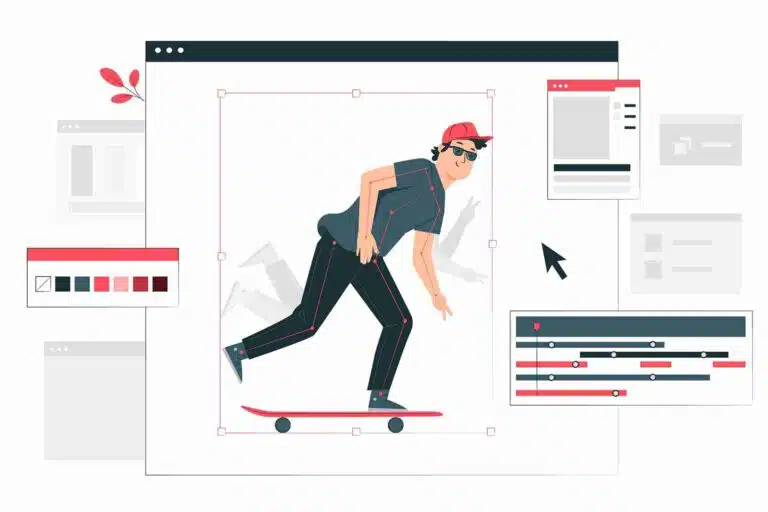Last Updated on September 18, 2024
Article Contents
10+ Uses & Applications of Animation in Different Industry Sectors
Animation has grown far beyond its origins in entertainment, transforming into a versatile tool across a wide range of industries. From simplifying complex concepts in education to visualizing product designs in engineering, the application of animation has proven to be a powerful tool for storytelling, marketing, and problem-solving. In this post, we’ll explore the use cases of animations in various sectors, helping businesses, educators, healthcare professionals, and more convey ideas in a clear and engaging manner.
What is Animation?
Animation is the process of creating moving images or visual effects, often through a sequence of frames, to give the illusion of motion. It can be 2D or 3D, and it’s widely used for entertainment, education, marketing, and product visualization. The application of 3D animation has expanded dramatically in recent years, making it a popular choice for creating lifelike simulations, product demos, and interactive experiences.

Animation simplifies complex information, making it easier for audiences to understand and engage with content. Whether used in a film, educational tool, or product showcase, animation provides a dynamic way to convey a message that static images or text simply cannot achieve.
Applications of Animation Across Different Sectors
Animation is now a key part of various industries, revolutionizing how information is presented, how stories are told, and how products are marketed. Let’s take a look at what are the use cases of animations across multiple fields.
Entertainment Industry
When we think of animation, the entertainment industry is likely the first thing that comes to mind. Animation has been a cornerstone of the film and television sectors for decades. From classic cartoons to cutting-edge CGI in blockbusters, animation enhances storytelling and brings characters, worlds, and action sequences to life.
- Film and Television: Animation allows filmmakers to create fantastical worlds and effects that would be impossible with live action alone. Popular franchises like “Toy Story,” “Shrek,” and countless animated series demonstrate how integral animation is in modern entertainment.
- Special Effects: Even in live-action films, animation plays a crucial role through CGI. Filmmakers use it to create explosions, characters, or backgrounds that wouldn’t be feasible or safe to produce in real life.
Education and E-Learning
One of the most impactful use case of animation is in education. Animations simplify complex concepts, making them easier to understand, especially in subjects like science, math, and history. By using animation, educators can break down complicated ideas into more digestible visual content, enhancing student engagement and retention.
- Interactive Learning with 3D Animation: Interactive animated modules allow students to explore topics in more depth, encouraging hands-on learning. For example, virtual labs with 3D animated simulations can help students visualize chemical reactions or explore outer space.
- Impact of 3D Animated Simulations in Virtual Classrooms: In virtual learning environments, 3D animations make lessons more interactive, simulating real-world scenarios that traditional textbooks and static images cannot.
Healthcare and Medical Visualization
In healthcare, 3D animation has become an essential tool for explaining medical procedures, demonstrating complex bodily functions, and training medical professionals.
- Explaining Procedures to Patients: Many patients feel overwhelmed when receiving complex medical information. 3D animated videos are now being used by healthcare providers to walk patients through medical procedures, giving them a clearer understanding of what to expect during surgeries or treatments.
- Training Medical Professionals: Animation is also used in training, allowing doctors and nurses to practice techniques or understand anatomical details through realistic 3D simulations before performing actual procedures.
Marketing and Advertising
In marketing and advertising, animation has become a go-to strategy for creating engaging content that captures attention and delivers information effectively.
- 3D Product Demos: One key use case of 3D animation in marketing is product demos. By showcasing the inner workings of a product, or highlighting features in an engaging way, 3D animations make it easier for potential customers to understand the value of a product without needing to see it in person.
- Explainer Videos: Many brands use animated explainer videos to introduce services or products. These videos simplify complex ideas into digestible chunks, making it easier for consumers to grasp the benefits of a product or service.
Architecture and Real Estate
In the architecture and real estate industries, 3D animation plays a transformative role, allowing potential buyers and clients to visualize properties and developments before they’re even built.
- 3D Animated Walkthroughs: Architects and real estate agents use 3D animated walkthroughs to give clients a virtual tour of properties. These tours allow viewers to “walk through” homes or office spaces, exploring layouts and interior designs without needing to visit the property in person.
- Construction and Design: Animation helps architects and designers showcase how a building or project will look once completed, offering clients a detailed view of the final product.
Manufacturing and Engineering
Manufacturing and engineering sectors benefit greatly from animation by using it to visualize product designs and streamline the development process.
- Visualizing Product Designs: Engineers use 3D animations to create detailed visualizations of product prototypes. This enables them to test the functionality of a design before creating a physical prototype, saving both time and resources.
- Iterating on Designs: Animation makes it easier to spot potential flaws in a product’s design and make necessary revisions early in the process. By visualizing the product in a 3D environment, engineers can run simulations and make improvements before manufacturing begins.
Creative Arts
In the creative arts, animation is not only used to tell stories but also to develop characters and world-building in ways that captivate audiences.
- Storytelling and Character Development: Animation allows creators to push the boundaries of storytelling, from developing complex characters to designing imaginative worlds that resonate with viewers. The emotional depth and visual richness that animation provides are unmatched in traditional media.
Gaming
The gaming industry thrives on animation, using it to create immersive worlds, character movements, and interactions that draw players into the game.
- Creating Immersive Game Worlds: Animation is central to gaming, allowing developers to build detailed game environments and realistic character movements. From the dynamic, lifelike animations in AAA games to the quirky, stylized visuals in indie titles, animation helps shape the gaming experience.
- Character Animations: Games rely on animated characters to create believable interactions and convey emotion. Whether it’s a character’s facial expressions or their battle stances, animation brings these virtual personalities to life.
Simulations
In fields such as science, aviation, and military training, simulations that use animation help professionals visualize and interact with complex data or scenarios.
- Scientific Visualization: Animation is often used in scientific fields to represent complex phenomena like the behavior of molecules, weather patterns, or the workings of the human brain. By transforming data into visual formats, scientists and researchers can better understand and communicate their findings.
Data Visualization
Another key application of animation is in data visualization, where motion graphics and animations make it easier for viewers to understand and engage with large datasets.
- Engaging Data Presentations: Animations turn static charts and graphs into interactive, engaging presentations. This approach is particularly useful for showing changes over time, as animation can visually demonstrate trends and patterns in data.
- Simplifying Complex Data: Whether you’re presenting business analytics or scientific data, animation makes large, complex datasets easier to digest by guiding the viewer through the information step by step.
E-commerce
In e-commerce, animations help potential customers get a closer look at products, enhancing their shopping experience.
- Animated Product Demos: E-commerce businesses use animated demos to show how products work, especially when customers can’t physically interact with the product before buying. These demos provide a more engaging and detailed look at product features, leading to higher conversion rates.
Conclusion
The use cases of animation is far-reaching, touching industries as diverse as healthcare, education, marketing, and real estate. From simplifying complex ideas to creating immersive experiences, animation has become an essential tool for communication and creativity in the modern world. Whether it’s a 3D animation of a product demo in marketing or an animated medical simulation for patient education, animation continues to shape how we engage with information across industries.
By understanding how different sectors use animation, businesses and professionals can leverage its power to improve storytelling, boost engagement, and drive better results. If you haven’t considered incorporating animation into your industry’s workflow, now is the time to explore the possibilities and elevate your communication strategies.

